The dairy alternatives market consists of sales of soy milk, rice milk, oat milk, coconut milk, and flaxseed milk, cheese substitutes comprise soft cheese and hard cheese, butter alternatives such as nut butter, coconut butter, vegetable oil blends, cultured vegan butter, and other dairy alternatives.Values in this market are ‘factory gate’ values, that is the value of goods sold by the manufacturers or creators of the goods, whether to other entities (including downstream manufacturers, wholesalers, distributors and retailers) or directly to end customers.
The value of goods in this market includes related services sold by the creators of the goods.
Dairy alternatives are foods that are used as a substitute for dairy products. These products are extracted from plants including cereals (rice, oats), legumes (soy), seeds (hemp, flax), nuts (peanuts, almond), and other grains (teff, quinoa).
Asia Pacific was the largest region in the dairy alternatives market in 2022.Western Europe was the second-largest region in the dairy alternatives market.
The regions covered in the dairy alternatives market are Asia-Pacific, Western Europe, Eastern Europe, North America, South America, Middle East and Africa.
The main product types are non-dairy milk, butter, cheese, yogurts, ice cream, and other product types.Butter is a yellow-to-white solid emulsion of fat globules, water, and inorganic salts and is produced by churning the cream from cows’ milk.
The various sources of dairy alternatives are almond, soy, oats, hemp, coconut, rice, and other product types. The dairy alternatives are distributed through supermarkets, health food stores, pharmacies, convenience stores, online stores, and other product types.
Increasing cases of lactose intolerance and milk allergies are projected to contribute to the dairy alternatives market’s growth.Lactose intolerance or congenital lactase deficiency is a situation wherein the small intestine is incapable of making the enzyme lactase to break down or digest lactose, moving undigested lactose to the large intestine, causing symptoms such as diarrhoea, gas, and bloating.
According to the Cleveland Clinic, more than 30 million people in America are lactose intolerant. This scenario is likely to generate higher demand for dairy alternatives, which in turn, is anticipated to boost the market’s revenue over the forecast period.
A lack of awareness among consumers about the nutritional benefits of dairy alternative products is expected to hinder the growth of the market.Many dairy consumers feel that dairy substitutes are lower in nutritional content than cow’s milk and other dairy products.
According to a Cargill study, about 90% of households in America consume dairy products as a part of their daily diets, whereas only 4% of the population consumes only non-dairy products. Therefore, the lack of awareness among the populace about the nutritional benefits of dairy alternatives is expected to hinder the growth of the market over the next few years.
New product innovation is the trend in the dairy alternative market. In June 2022, Nestlé S.A, a Swtizerland-based multinational food, and drink processing conglomerate corporation, announced the launch of Little Steps Plantygrow, a plant-based growing-up drink for toddlers from one to three years of age. According to Nestlé S.A, it contains iron, vitamins A, C, B2, B12, and iodine, no additional carbohydrate, and enhanced with omega3 and 6 for the overall development of toddlers.
In May 2021, Saputo Inc , a Canada-based dairy company acquired Bute Island Foods for an undisclosed amount.Through this acquisition, Saputo Inc aims to strengthen its product portfolio in plant-based dairy alternatives and to gain a competitive advantage in the market.
Bute Island Foods is a UK-based cheese producer.
The countries covered in the dairy alternatives market report are Australia, Brazil, China, France, Germany, India, Indonesia, Japan, Russia, South Korea, UK, and USA.
The market value is defined as the revenues that enterprises gain from goods and/or services sold within the specified market and geography through sales, grants, or donations in terms of currency (in USD ($) unless otherwise specified).
The revenues for a specified geography are consumption values – that is, they are revenues generated by organizations in the specified geography within the specified market, irrespective of where they are produced. It does not include revenues from resales either further along the supply chain or as part of other products.



